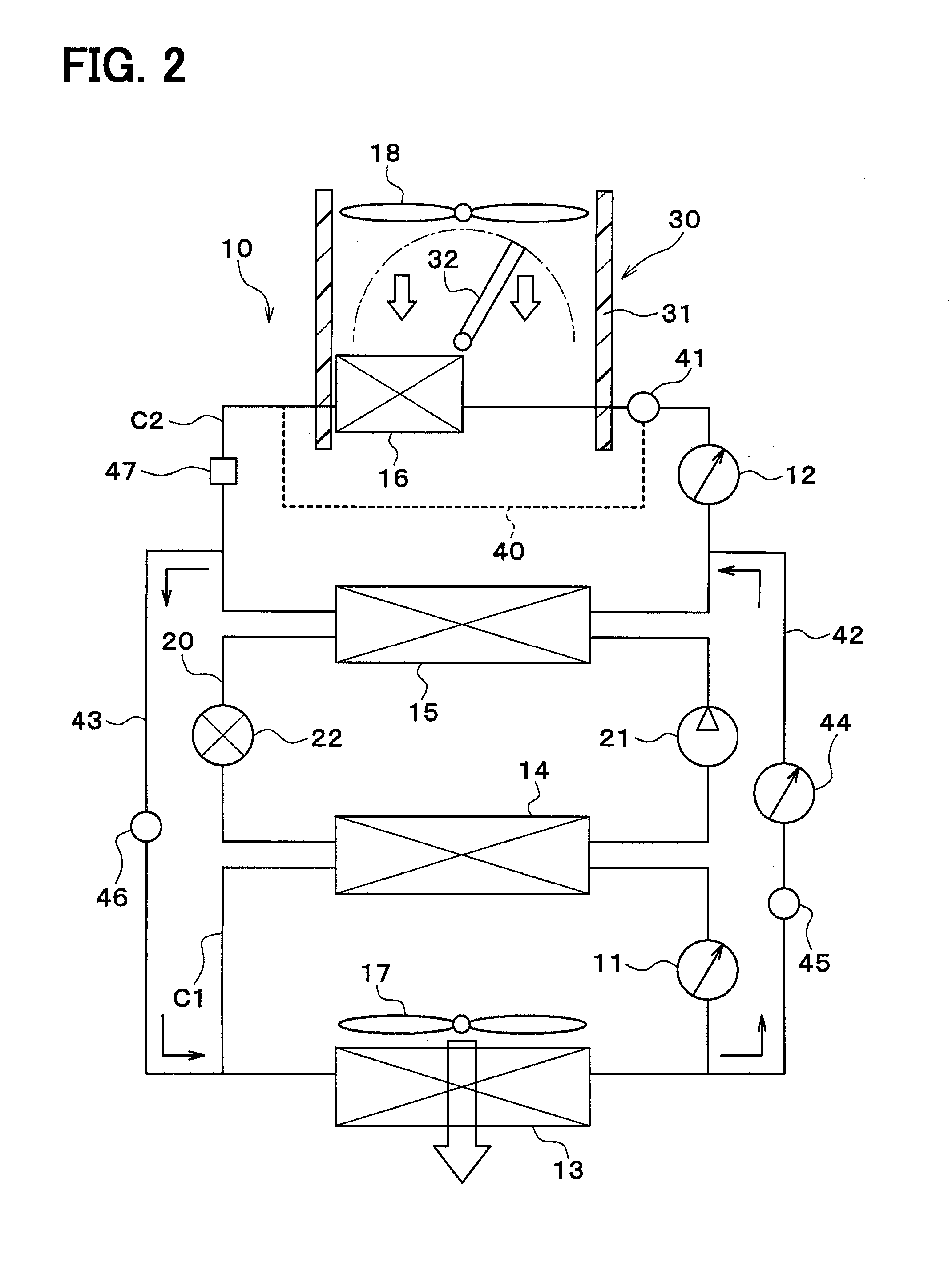Vehicular heat management system
a heat management system and vehicle technology, applied in the direction of engine-driven generators, transportation and packaging, light and heating equipment, etc., can solve the problems of refrigerant leakage into the vehicle interior, damage to the exterior heat exchanger, and release of refrigerant, so as to increase the temperature of the first heat medium
- Summary
- Abstract
- Description
- Claims
- Application Information
AI Technical Summary
Benefits of technology
Problems solved by technology
Method used
Image
Examples
first embodiment
[0040]A vehicular heat management system 10 (refrigeration cycle device) shown in FIG. 1 is used to appropriately adjust temperatures of various devices provided in a vehicle and a vehicle interior. In the present embodiment, the vehicular heat management system 10 is applied to a hybrid vehicle that obtains a drive force for the traveling of the vehicle from an engine (internal combustion engine) and a traveling electric motor.
[0041]The hybrid vehicle of the present embodiment is formed as a plug-in hybrid vehicle that can charge a battery (in-vehicle battery), which is mounted on the vehicle, with an electric power that is supplied from an external power supply (commercial power supply) at a time when the vehicle stops. For example, a lithium-ion battery can be used as the battery.
[0042]The drive force, which is output from the engine, is not only used for the traveling of the vehicle, and but also used for the operation of a generator. Further, an electric power generated by a ge...
second embodiment
[0140]In a second embodiment of the present disclosure, points different from the above-mentioned first embodiments will be described. The second embodiment is different from the first embodiment in a control process performed by a controller 50. In a state in which a vehicular heat management system 10 is switched to the non-communicating mode, the controller 50 performs a control process illustrated in the flowchart in FIG. 5.
[0141]At step S200, whether or not the temperature TW1 of coolant that flows in a first coolant circuit C1 is lowered to a level lower than a first predetermined temperature Ti is detected. The first predetermined temperature Ti is a value memorized in the controller 50 in advance.
[0142]When the temperature TW1 of coolant that flows in the first coolant circuit C1 is determined not to be lower than the first predetermined temperature Ti at Step S200, Step S200 is repeated. Therefore, the non-communicating mode is maintained.
[0143]When the temperature TW1 of c...
third embodiment
[0172]In the above-mentioned embodiments, the mode was switched between the communicating mode and the non-communicating mode by the first, second on / off valves 45, 46. However, in the present embodiment, the mode is switched between the communicating mode and the non-communicating mode by a first switching valve 61 and a second switching valve 62 as illustrated in FIG. 9.
[0173]In the present embodiment, a vehicular heat management system 10 includes a heat generating device 63. The heat generating device 63 is a heat generating apparatus that generates heat in association with an operation. The heat generating device 63 is an apparatus including a flow channel in which coolant flows, in which the heat is received by the coolant (temperature adjustment-target device).
[0174]Examples of the heat generating device 63 include an inverter, a battery, a traveling electric motor, an engine, and a fuel cell. The inverter is a power conversion device that converts a DC power, which is suppli...
PUM
 Login to View More
Login to View More Abstract
Description
Claims
Application Information
 Login to View More
Login to View More - R&D
- Intellectual Property
- Life Sciences
- Materials
- Tech Scout
- Unparalleled Data Quality
- Higher Quality Content
- 60% Fewer Hallucinations
Browse by: Latest US Patents, China's latest patents, Technical Efficacy Thesaurus, Application Domain, Technology Topic, Popular Technical Reports.
© 2025 PatSnap. All rights reserved.Legal|Privacy policy|Modern Slavery Act Transparency Statement|Sitemap|About US| Contact US: help@patsnap.com



